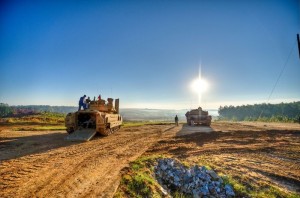FORT BENNING, Ga.: Bradley Fighting Vehicle and tank crews from the Maneuver Center of Excellence fired on the Digital Multi-Purpose Range Complex this week as part of a government acceptance test, one of the final tasks to complete before the complex is ready for Soldier training.
The goal of the test was to evaluate the extensive digital instrumentation systems at the complex, said Col. Ryan Kuhn, commander of the 197th Infantry Brigade, which has played a significant role in certifying the DMPRC.
“Our Soldiers were tasked to test the resiliency of the range complex by gaining an understanding of the limitations of the range and maximizing the capabilities of the instrumentation to identify any possible feedback that could enhance the functionality of the range or identify additional risk-mitigation measures,” the colonel said.
In a combined effort between the Infantry and Armor schools, Soldiers with the 197th Infantry Brigade’s 1st Battalion, 29th Infantry Regiment, along with tank crews from the 1st Battalion, 16th Cavalry Regiment, 316th Cavalry Brigade, performed the firing test. The 316th Cav. Bde. and the 194th Armored Brigade, both of Fort Knox, Ky., will make the move to Fort Benning over the next 12 months and into facilities at Harmony Church.
 The 1,800-acre complex funded by U.S. Army Forces Command and built by the U.S. Army Corps of Engineers, Savannah District, was designed to support combined arms live-fire exercises and advanced-gunnery qualifications. The range supports company-sized elements performing crew and collective gunnery tasks – such as individual crew, section and platoon qualifications.
The 1,800-acre complex funded by U.S. Army Forces Command and built by the U.S. Army Corps of Engineers, Savannah District, was designed to support combined arms live-fire exercises and advanced-gunnery qualifications. The range supports company-sized elements performing crew and collective gunnery tasks – such as individual crew, section and platoon qualifications.
The range is designed for tanks and Bradley Fighting Vehicles but can also support Stryker training and, beginning next year, Apache gunnery qualification.
Prior to the DMPRC’s construction, Fort Benning did not have a range capable of supporting platoon qualifications, said John Horvath, the DMPRC range division’s site supervisor.
Soldiers either had training standards modified or were transported to Fort Stewart, Ga., 200 miles away.
The digital range is outfitted with high-tech instrumentation to transmit live video feeds and real-time situational awareness back to the range operations center as training scenarios unfold, Horvath said.
The information can be used by platoon leaders and commanders to assess training needs and conduct after-action reviews.
The complex has 35 stationary Infantry target clusters, 11 evasive moving Armor targets, 55 stationary Armor targets, three defense trenches with fortified bunker emplacements, 18 defilade positions and a helipad for use as an emergency evacuation site.
Field video cameras with day optic and thermal technology cover every inch of the complex and transmit data on the status of targets, firing positions and other information units can use to evaluate their success during the training scenarios, Horvath said.
Additional data is gathered by Integrated Player Units installed in the vehicles. The IPUs provide global-positioning-system data and 1553 standard military bus data, which is pumped back to the range operations center, where the training scenarios are observed and evaluated.
“The data can tell us the turret’s orientation, which weapon is selected, if it’s on safe or armed … whether targets are active, exposed or hidden … everything’s recorded,” Horvath said. “It provides good after-action review input to correct their mistakes.”
Col. Kuhn said the training advantage for Soldiers will be tremendous.
“This range will become the premier live-fire training venue on the installation … the aspect that provides the most advantage over other ranges on the installation is its size and the varied terrain combined with the newest digital technologies for assessment and control procedures,” he said.
“With the addition of the DMPRC, our leaders can coordinate and develop virtually any type of scenario necessary to replicate the current operating environment we will deploy to,” the colonel said.
Sgt. 1st Class Vernon Prohaska, liaison officer for relocation operations in the U.S. Army Armor Center and School’s Strategic Plans Cell, said the state-of-the-art digital training facility will prepare Soldiers for the battlefield by “helping them to understand every scope of their training prior to deployment.”
Prohaska, who worked as an Armor School representative during the complex’s design phase, said the video system and field optics are his favorite aspect of the DMPRC.
Additionally, the complex’s close proximity to Harmony Church is something Soldiers will appreciate, he said.
The post’s other two training ranges, Hastings and Karmouche, are a good distance from Kelley Hill and Harmony Church, with Hastings being nearly 60 miles away roundtrip.
Hastings is currently undergoing renovations and being converted from a four-lane range to a two-lane multi-purpose training range that will compete with current gunnery standards and new heavy brigade combat team standards. It is expected to reopen in October 2011. Karmouche, an older range, was recently changed from a one-lane to a two-lane range in order to update gunnery patterns, Prohaska said.
The 75th Ranger Regiment is scheduled to conduct live-fire platoon training at the DMPRC in late November. The 3rd Heavy Brigade Combat Team will conduct new equipment training there in the spring.









